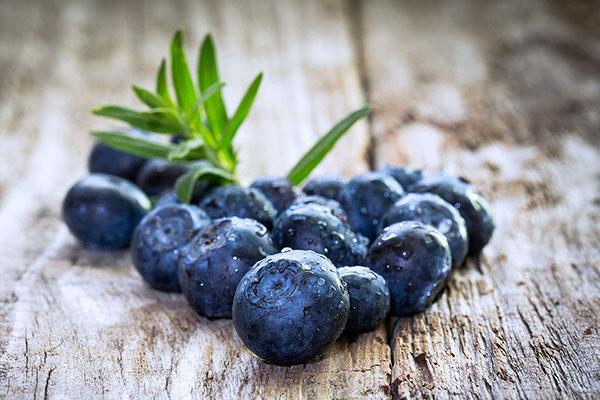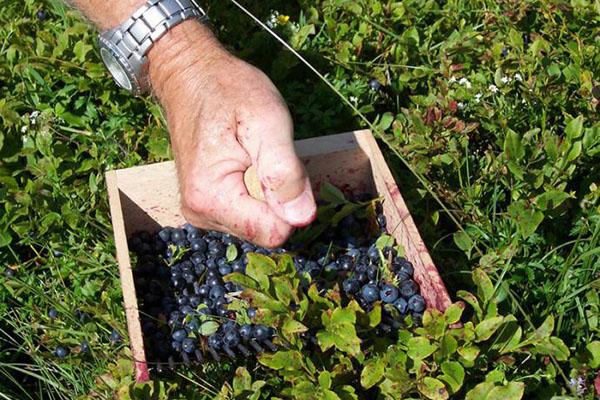Growing blueberries in the garden: planting, reproduction, care
 It's no secret that berries contain many valuable elements. That is why growing blueberries in the garden has become a favorite pastime for many summer residents. Now it is not necessary to pick up a basket and look for valuable fruits among the forest thickets. With a little effort, you can grow blueberries in your area and reap a bountiful harvest. What is this mysterious bush? Are there any secrets to growing it? How valuable are blueberries? Having received answers to questions, perhaps someone wants to plant a wild berry in their garden.
It's no secret that berries contain many valuable elements. That is why growing blueberries in the garden has become a favorite pastime for many summer residents. Now it is not necessary to pick up a basket and look for valuable fruits among the forest thickets. With a little effort, you can grow blueberries in your area and reap a bountiful harvest. What is this mysterious bush? Are there any secrets to growing it? How valuable are blueberries? Having received answers to questions, perhaps someone wants to plant a wild berry in their garden.
"Look at me from the side"

Before you start growing blueberries in your garden, it would be wise to get to know this cute plant. In nature, the culture is found in the humid forests of northern Europe and America. Low bushes can be found in the taiga. And in the subtropics, blueberries look like a lush curly shrub, strewn with berries.
The habitat shows that blueberries are not afraid of both severe frosts and intense heat.
Bilberry belongs to the Heather family and is a low shrub. It grows up to about 0.5 m. In extreme conditions of the North it reaches only 10 cm. The plant has a main trunk, from which shoots extend at an acute angle. Each of them grows successive ovoid leaves with finely serrated edges. The back of the plates is pale, and the front is light green. Due to this structure and shape, rainwater drops flow down them to the main trunk, feeding the root with moisture.
 Blueberry blooms in May. Single buds are white with a greenish tint. They are lowered to protect them from excessive moisture. Since the plant is considered a honey plant, pollination occurs using bees or bumblebees.
Blueberry blooms in May. Single buds are white with a greenish tint. They are lowered to protect them from excessive moisture. Since the plant is considered a honey plant, pollination occurs using bees or bumblebees.
The fruit is round and bluish-black in color. The outer part is covered with a waxy coating, which can be easily washed off with water. The pulp is colored purple. Inside the berry there are miniature bones, which number from 20 to 40 pieces.
The early varieties are harvested in July. Late options are in late September and early October.
Growing blueberries in the garden: choosing a variety
Thanks to the hard work of breeders, today there are many varieties of blueberries.
Let's consider only the most popular ones:
- Blue Gold. The shrub can grow up to 1.2 m in height. It has many shoots covered with berries, which ripen in early August.

- Torro. Compact, but stocky bushes grow about 1.8 m. Berries are large in size. They are painted dark blue. The culture tolerates cold winters wonderfully while continuing to bear fruit.

- Blue Crop. The variety is distinguished by its large but firm fruits, which ripen in July. They reach 20 mm in diameter. Up to 7 kg of berries are harvested from one bush annually.

- Earley Blue. It belongs to the early varieties that bear fruit for a long time. Large berries have a sweetish taste, reminiscent of grapes. Blueberry pulp is juicy and contains many nutrients.

Of course, it is impossible to describe all known varieties of the crop.But thanks to the variety, it is possible to choose the appropriate option. And then growing blueberries in the garden will bring true satisfaction.
Berries are often used to treat various diseases because they contain large amounts of manganese, organic acids, carotene, tannins and vitamins.
Secrets of planting shrubs at their summer cottage
 Since blueberries naturally grow in humid forests, the first step is to choose a suitable place for them. From this it follows that the plant loves partial shade and an abundance of moisture. If you plant a crop among fruit trees or ornamental shrubs, it will bear an abundance of fruit.
Since blueberries naturally grow in humid forests, the first step is to choose a suitable place for them. From this it follows that the plant loves partial shade and an abundance of moisture. If you plant a crop among fruit trees or ornamental shrubs, it will bear an abundance of fruit.
The cultivation of blueberries begins with the preparation of the soil, since it does not develop well in ordinary land. There were times when young bushes dried up in the midst of fruiting.
Therefore, in the garden where the culture will grow, the soil is first prepared:
- a funnel of 150 by 150 cm is pulled out, the depth of which is at least 60 cm;
- the excavated soil is mixed with peat (2: 1);
- powdered sulfur is added to the mixture to give it the necessary acidity;
- for the severity of the substrate, a little river sand or last year's oak leaves are introduced.
The process of preparing the soil begins in August so that by the time the plant is planted, it is in perfect condition. However, many are interested in when to plant blueberries, in spring or autumn. Experts say that it is best to do this in October.
Landing rules
 Most often, small shrubs are used for growing crops, which are no more than 3 years old. They are planted at a distance of 1.5 m from each other. If several rows are supposed, then the gap should be at least 2.5 m. It is important to understand how blueberries grow in the country and when they bear fruit.
Most often, small shrubs are used for growing crops, which are no more than 3 years old. They are planted at a distance of 1.5 m from each other. If several rows are supposed, then the gap should be at least 2.5 m. It is important to understand how blueberries grow in the country and when they bear fruit.
The prepared pits are irrigated with water, after which the planting material is lowered there. If there is an earthen lump on the rhizome, it is carefully loosened, being careful not to damage it. Then the plant is lowered into a hole, sprinkled with soil and the upper ball is compacted.
To preserve moisture, you can sprinkle the area near the trunk with fallen leaves or sawdust.
Available ways to propagate blueberries
 To arrange an exquisite berry meadow in your garden, it is not necessary to immediately acquire a lot of bushes. It is enough to plant one plant, and over time, start breeding blueberries on the site.
To arrange an exquisite berry meadow in your garden, it is not necessary to immediately acquire a lot of bushes. It is enough to plant one plant, and over time, start breeding blueberries on the site.
There are several ways to create a berry meadow in the garden:
- using seeds;
- cuttings;
- division of the bush.
Let's consider in detail the technology of each option.
Enduring "classic of the genre" - seed reproduction
 The simplicity of this method makes it possible to grow garden blueberries even for novice gardeners. Planting material is taken from fully ripe fruits. They are often colored deep blue, dense and firm enough to the touch. Then they are thoroughly crushed, and then filled with water. Seeds that have sunk to the bottom of the container are the ideal planting material. Then they are taken out of the water to dry thoroughly.
The simplicity of this method makes it possible to grow garden blueberries even for novice gardeners. Planting material is taken from fully ripe fruits. They are often colored deep blue, dense and firm enough to the touch. Then they are thoroughly crushed, and then filled with water. Seeds that have sunk to the bottom of the container are the ideal planting material. Then they are taken out of the water to dry thoroughly.
While the seeds can be sown straight away, some gardeners advise placing them in the refrigerator for stratification.
The next step is to mix the peat with sand and fill a suitable container. The surface of the soil is slightly moistened with a spray bottle, after which the seeds are sown. To create a greenhouse effect, the container is covered with foil or glass. At the same time, the crops are aired daily and watered regularly. The greens will appear in 2-3 weeks.
If the seeds were sown in the fall, the containers are kept in a room where the room temperature is maintained. In the spring, seedlings dive, leaving stronger varieties. Blueberries are planted on the garden bed only after a year.
Using cuttings
 Breeding material is cut from mature bushes of plants that are already growing in the garden. This is best done at the end of the summer.Strong and healthy branches are suitable, which are first soaked in a root growth stimulator. Then the cuttings are planted in containers with peat soil and watered abundantly. To create greenhouse conditions, they are covered with foil, not forgetting to air the seedlings every day. By mid-fall, the cuttings will take root and be ready for planting.
Breeding material is cut from mature bushes of plants that are already growing in the garden. This is best done at the end of the summer.Strong and healthy branches are suitable, which are first soaked in a root growth stimulator. Then the cuttings are planted in containers with peat soil and watered abundantly. To create greenhouse conditions, they are covered with foil, not forgetting to air the seedlings every day. By mid-fall, the cuttings will take root and be ready for planting.
Division of bushes
 The procedure is carried out in the middle of autumn. To do this, dig up an adult plant and use a knife to divide it into several parts. Each of them should have approximately 5 buds. The bushes are planted in a prepared area.
The procedure is carried out in the middle of autumn. To do this, dig up an adult plant and use a knife to divide it into several parts. Each of them should have approximately 5 buds. The bushes are planted in a prepared area.
As you can see, planting and caring for blueberries in the garden does not require any special skills. It includes regular watering, soil fertilization, and periodic pruning. And the breeding process is available even to an inexperienced gardener. Applying the advice, it is not at all difficult to grow a lush blueberry meadow in your summer cottage.